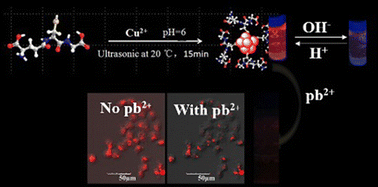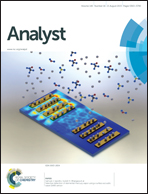Facile sonochemical synthesis of pH-responsive copper nanoclusters for selective and sensitive detection of Pb2+ in living cells†
Abstract
A one-pot sonochemical reaction of Cu(NO3)2 with glutathione (GSH), the latter functioning as a reducing agent and a stabilizing agent, rapidly affords Cu nanoclusters (NCs). The as-prepared GSH–CuNCs possess a small size (∼2.2 ± 0.2 nm), red luminescence with quantum yield (5.3%), and water-dispersibility. Moreover, the fluorescence of the as-prepared GSH–CuNCs is responsive to pH so that the intensity of fluorescence increases rapidly with decreasing pH from 9 to 4. Besides, the GSH–CuNCs would be aggregated by Pb2+ ions in aqueous solution which results in quenching of the fluorescence. Therefore, such GSH–CuNCs would be excellent candidates as fluorescent probes for the label-free detection of Pb2+ with the limit of detection at 1.0 nM. Importantly, CAL-27 cells are used as models to achieve potential application as probes for monitoring Pb2+ in living cells. Thus, these fluorescent CuNCs could work as an alternative to conventional fluorescent probes for biolabeling, sensing and other applications.


 Please wait while we load your content...
Please wait while we load your content...